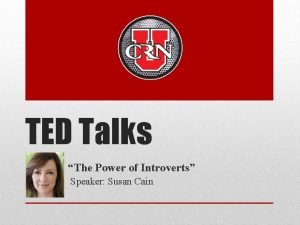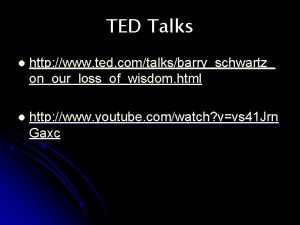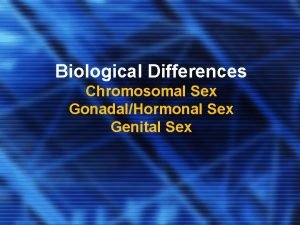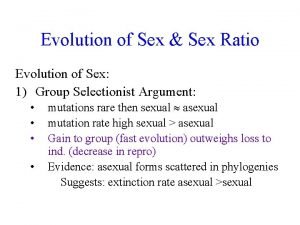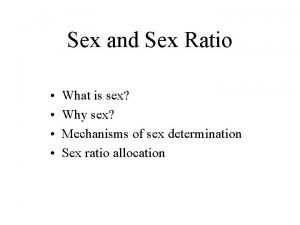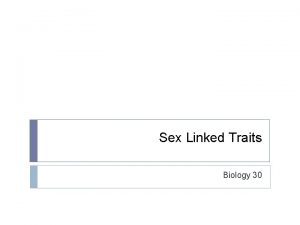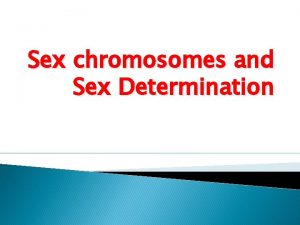SEX Psych 320 TED Talks Take out a

























- Slides: 25

SEX… Psych 320

TED Talks • Take out a piece of paper Tell me 2 things you got from each of the following talks: Sam Killerman: Understanding the complexities of gender The guy with the salmon pants and a beard Daphna Joel: Are brains male or female? The Israeli professor discussing neuroscience of gender i. O Tillet Wright: Fifty shades of gay The one with all the pictures

SEX • “I don’t know the question, but sex is definitely the answer” – Woody Allen • “I’m a heroine addict. I need to have sex with women who have saved someone’s life” – Mitch Hedberg • “Sex is a part of nature. I go along with nature” – Marilyn Monroe • “I know a man who gave up smoking, drinking, sex and rich food. He was healthy right up to the day he killed himself” – Johnny Carson • “I would rather have a cup of tea than sex” – Boy George • “Everything in the world is about sex except sex. Sex is about power” – Oscar Wilde • “Sex appeal is 50% what you’ve got and 50% what people think you’ve got” – Sophia Loren • “The evolution of sex is the hardest problem in evolutionary biology” – John Maynard Smith

So why does “sex” exist? • What are the advantages of reproduction? • What are the costs? • Why would anyone want to do this? • How would anyone want to do this?

Sex through an evolutionary lens • Darwin’s Sexual Selection: The “struggle between males for possession of females; the result is not death to the unsuccessful competitor, but few or no offspring” (Darwin, 1859, pg. 88). Sexual dimorphism – different characteristics based on sex/gender Another phrase – “differential phenotypes based on gender” For instance Male ornamentation Size differences Structural differences in parts of the brain

Short aside… some definitions • Sexual dimorphism – differential “phenotypes” based on sex/gender Phenotype A set of observable characteristics of an individual resulting from the interaction of its genotype with the environment Genotype The genetic constitution of an individual organism Dimorphic Occurring in or representing two distinct forms Polymorphic Occurring in multiple forms (often “several”)

Short aside… some (more) definitions • Some more… in prepping for later in this lecture Sex – could mean coitus/the act of sex, or biological sex (see below) Gender – the state of being male or female – often societally defined Gender identity – how one experiences their gender Gender expression – how one outwardly depicts their experience Biological Sex – the sex organs… (most often: ) what you’re born with – often correlates with the two above, but not always Cisgender – a person’s gender identity and expression corresponds with biological sex Remember that this is all determined societally… and society has influenced how we study (and what we study) scientifically as well as how we define things… ”Biological sex” could accordingly refer to just the visible stuff or all of the biological components that make up gender, including all internal sex organs and brain differences Sexuality – NOT the same thing and NOT directly linked to gender But! – “sexuality” can correspond to gender – leading us to make assumptions LGBTQIA – gender identity (but can refer to expression) Lesbian; gay; bisexual/bigender; transsexual/transgender; queer; intersex; asexual/agender Heteronormative – denoting or relating to a world view that promotes heterosexuality as the normal or preferred sexual orientation Hetero vs homosexual – “homosexual” has most often been used in a heteronormative society and, as such, in a derogatory manner – as such, the term homosexual is not preferred

Sexual di(poly)morphism Male Ornamentation

And Size Differences Too… Sometimes functional too And not always the same

So… Why sex? • If you ask an evolutionary or biological psychologist: Why do we have sex? Allows for the continuance of species Allows for more genetic diversity Allows for faster and more efficient evolution Allows for genetic “repair” Services social norms Produces help – around house, farm, later in life Produces joy – opportunity for bonding • What makes us want it (evolutionarily speaking)? In most other species, sex occurs quite rarely Most often occurs only when female is “receptive” based on cycling hormones Syrian hamsters, for instance Very little mounting on non-receptive females outside of “dominance displays” It is therefore argued that sex rarely occurs for “pleasure” and thus, is most often NOT driven by, for instance, the mesolimbic pathway (at least not in the way that it is in humans)

So… Why sex? • What makes us want it (evolutionarily speaking)? But in humans and some other species (e. g. Bonobos {monkeys}), sex often occurs NOT as a means to a reproductive end Not all are as straightforward as pleasure Dopamine and oxytocin release Pleasure, bonding, connectedness, and security Stress relief Boosts immunity Reduces pain • So what makes us want it, then? Arguments are that only through developing the pleasure did we actually survive natural selection Because: “Sex is ‘gross’, ‘risky’, altogether ‘dangerous’” Thought questions – If sex/reproduction are these things, how/why do other animals still do it? How do are humans similar/dissimilar from other animals? What brain regions do you think are involved in this? Because we developed cortices (and can thus better predict the dangers associated with reproduction), we needed also to develop the ability to overcome those inhibitions – to overcome the “PFC-like control” To become more “animalistic”; “primal”; “emotional”… and less “rational” Another thought question to ponder – how can this (partially) explain taboo behaviors?

Sex and the Brain So what underlies that “primal” disinhibition? Disinhibition = to turn off the off button (so to turn something on) • Simply put – the brain. More specifically, the hypothalamus. (The “R” of the 4 “F”s) • But important to note the presence of individual differences (i. e. between, within, and without “genders”) • So… in covering those, its best we start with development •

Sex and the Brain So what underlies that “primal” disinhibition? Disinhibition = to turn off the off button (so to turn something on) • Simply put – the brain. More specifically, the hypothalamus. (The “R” of the 4 “F”s) • But important to note the presence of individual differences (i. e. between, within, and without “genders”) • So… in covering those, its best we start with development • And obviously, this isn’t sex ed… but assuming we all recall the basics, I’ll run through some things quickly – Biological sex is initially differentiated by the presence of a “Y” chromosome: XX = typically developing “female” XY = typically developing “male” Sex organs: The gonads The ovaries and testes The internal sex organs Fallopian tubes; uterus; fimbria; inner 2/3 of vagina Epididymis; vas deferens; seminal vesicles External sex organs The visible stuff

Sex and the Brain: Development • The default and the Sry gene Simply put – the default developmental pathway is feminization That is – all of the coding for development is present in the X chromosomes. The Y chromosome only offers a “competition of pathways” during development that, if it wins out, typically leads to the development of a fully functional (sexually speaking), heterosexual “male” The presence of the Sry gene (on the Y chromosome): Also called the “sex determining region Y” This gene, when transcribed into a protein, signals the development of testes If the Sry gene is absent (or somehow silenced), ovaries develop Cases of XX males have been reported If the Sry gene is “translocated” from the X to the Y chromosome of the father, and father gives this “X” gene 1996 Olympic games in Atlanta – a probe to detect Sry gene began being used

Sex and the Brain: Development • 1. Once gonads develop (ovaries or testes), a series of events begin to determine the individual’s gender These are directed by hormones in utero and have organizational effects That is, they determine the development of a person’s sex organs and the brain These effects are permanent 2. These events also have activational effects. Which occur later in life, after sex organs have developed E. g. Production of sperm; erection/ejaculation; ovulation

Sex and the Brain: Development • In embryonic development, the development of internal sex organs are bisexual, meaning that all embryos contain precursors for both male and female organs Uterus; fallopian tubes; vans deferens; epididymis; seminal vesicles • However, during 3 rd month of gestation (end of 1 st trimester of pregnancy), only one develops while the other “withers away” Mullerian system: The developmental system responsible for the feminization of the embryo Wolffian system: The developmental system responsible for the masculinization of the embryo • Simply put, the testes (if the “Y” is present and the Sry is activated) release hormones to trigger the activation of the Wolffian system • If the Wolffian system (male) is not “turned on” by testes, then the Mullerian system is, by default, the driving developer.

Sex and the Brain: Development • That is to say, the Mullerian (female) system does not need to be “turned on”, but to be “turned off” Turner’s Syndrome: Results when a Y chromosome is defective or a second chromosome is altogether absent Because ovary development requires two X chromosomes, ovaries do not develop in Turner’s Syndrome But neither do testes Therefore, the Wolffian system (male) is not activated and the Mullerian (female) system defaults, yielding a fully feminized person that lacks ovaries • The first step in the turning on the Wolffian system is, therefore, for the testes to secrete two types of hormones called: Anti-Mullerian hormone: A peptide hormone which inhibits the activation of the Mullerian system and is thus defeminizing Androgens: Steroid hormones (testosterone and dihydrotestosterone) which are responsible for activating the Wolffian system and providing a masculinizing effect

Sex and the Brain: Development • There are two types of genetic disorders that demonstrate most dramatically the role of these two hormone types Androgen Insensitivity Syndrome: A genetic mutation that prevents the formation of functioning androgen receptors This XY containing person’s testes release anti-Mullerian hormone androgens normally but the absence of the androgen receptors does not allow for the development of the internal sex organs That is, no vans deferens; epididymis; or seminal vesicles Due to the presence of the anti-Mullerian hormone, female internal sex organs also do not develop. A newborn with AIS appears the be female and at puberty, develops the normal appearance of a post-pubescent female Typically diagnosed when menstruation does not occur The vagina is shallow and, of course due to the absence of a uterus and ovaries, this person is unable to have children Most, however, marry and lead normal sex lives. There is no evidence to suggest a proclivity for bisexuality or lesbianism Persistent Mullerian Duct Syndrome: A genetic mutation resulting from either the failure to produce anti-Mullerian hormone or the absence of anti. Mullerian hormone receptors. The Wolffian system leads to the development of internal sex organs As does the Mullerian system Thus these individuals have both male and female internal sex organs

Sex and the Brain: Development • External Genitalia – “the visible stuff” As the biological dictum states: “Nature’s impulse is to create a female” – Carlson, 2010 Accordingly, and as we’ve just seen, even female gonads/internal sex organs are not necessary to develop external genitalia Dihydrotestosterone, however, is necessary for male external genitalia development Testosterone is converted to dihydrotestosterone by an enzyme called 5 -alpha-reductase deficiency syndrome: A genetic deficiency that affects male sexual development prior to birth and at puberty Guevedoces of Dominican Republic – therefore (can be) hereditary Have XY chromosomes and testes but outward appearance of female ubiquitously until puberty At puberty, some do develop male appearances, including external genitalia, but most all lack considerably the development of facial and body hair and most are unable to father children Approximately ½ adopt male gender roles in adolescence or early adulthood according to the National Institutes of Health.

Sex and the Brain: Development • Another developmental trajectory: Congenital adrenal hyperplasia: A genetic condition characterized by the hypersecretion of androgens, especially prenatally In males, this appears to have no effect In females, this results in somewhat of a masculinization (to varying degrees) Including of the female external sex organs Females with CAH have an increased likelihood of being sexually attracted to other females Approximately 1/3 openly describe themselves as being lesbian or bisexual One of the major scientific explanations for this has been a focus on the roles that androgens play in the development of the brain, though it should be noted that the masculinization of sex organs shouldn’t be completely ruled out Research shows that young girls with CAH are more likely to self-select “boy”like things; (E. g. drawing pictures with male-like motifs – trucks, planes, trains as opposed to people, flowers and butterflies). Obviously – environmental reinforcements must be taken into account here, but should not be afforded much credit when discussing things generally (as opposed to a case by case basis)

Puberty and the Brain: A simple overview • Simply stated: At puberty, the hypothalamus stimulates the release of gonadotropin-releasing hormones These hormones (follicle-stimulating hormone and luteinizing hormone) are released in both males and females and stimulate each gender’s gonads to produce gender-specific hormone levels If you experimentally replace testes and ovaries in male/female rats, each responds identically to stimulation by these hormones. In rats w/ testes, this stimulates the secretion of testosterone and production of sperm In rats w/ ovaries, this stimulates the secretion of estrogens, namely estradiol Meaning – these pubertal effects (via gonadal hormones: androgens and estrogens) occur based on gonads, not all other aforementioned steps • These hormones contribute greatly to our “differentiation” but also to our behavior In nonhuman species – ovarian hormones control the “willingness” to mate In a like manner – testosterone controls the activation of sexual behavior – but it’s not perfectly straightforward. Castration (remove testes and thus testosterone) does not completely eliminate sexual behavior, at least not immediately Inhibiting testosterone has grander effects with those of lower social status (i. e. dominance relationships - think of “alpha males”)

Sexual Dimorphism – The brain • More accounts can be given as to the masculinization of “females” and the feminization of “males” and they all seem to have something in common – biology • The case of John/Joan (Bruce, Brenda, David) and Dr. Money • Sexually Dimorphic Nuclei (SDN) of the Brain Believed to be related to specific exposures of sex hormones Also believed that the vast dynamics of all of these hormones lead to more of a spectrum than dichotomy (arm/leg lengths in heterosexual males vs gay males and hetero females) • Specific SDNs Corpus Callosum Better connectivity in females and gay males (than hetero males) Suprachiasmatic Nucleus of the Hypothalamus Gay men have feminized SCNs Medial Preoptic Area of the Hypothalamus Critical for male sexual behavior Androgenized females have masculinized MPOAs and SCNs – “preference? ” Bed Nucleus of Stria Terminalis (BNST) Larger in males than in females and transsexual males (which is the same size as in females) --- “identity? ”

Sexual Dimorphism – The brain • Research on sexual preference and identity • As you can imagine – a delicate subject • Attacks abound – from either side, and research is often misquoted – (for example, as in “the marshmallow study”) “It’s a choice” “It’s a disease” “It’s a malfunction” • The research itself is often shoddy and not representative • Examples from nature also abound • Gay rams (Price et al. , 1998; Roselli et al. , 2004; Carlson, 2010) Approximately 8% of male rams (male sheep) display preference toward other males MPOA of males appears to be more feminized, with fewer grey matter and total neuron count

Sexual Dimorphism – The brain • Just some other species where homosexual behavior has been reported: Bonobos – roughly 60% of sexual behavior occurs between 2+ females Giraffes – mounting between males occurs at varied rates reporting between 30 and 94% of the time across several studies Lions – approximately 8% of mountings are reportedly male/male Dolphins… Birds. . . Insects. . . Laboratory rats. . . So now that we’ve talked about the “basics” – the “underlying biology” – we will in a future lecture, talk a bit more about “why” we engage in reproduction, pair bonding, etc. . . I. e. – Love; Devotion; Monogamy; etc. . .

Wrapping this up… • Some things to think about… Why do we have sex? Evolutionary, social and biological drives Why do we have sex or experience sex differently? Mosaics of different hormonal, proteinaceous, and environmental influences Why do we identify (i. e. gender) differently? Those same mosaics But CRITICAL to acknowledge social influences But what about “learning”? Can sexual preference be learned? (or unlearned? ) Aversion/Conversion therapy has been a brutal failure Most contemplate, attempt or succeed at suicide ”Success rates” are marred by deceitful attempts to escape
 Sex sex sex
Sex sex sex Sex sex sex
Sex sex sex Greenhouse sex
Greenhouse sex Xxtesticles
Xxtesticles Sex sex sex
Sex sex sex Ted talk the power of introverts
Ted talk the power of introverts Ted talks
Ted talks Metaphors in one direction songs
Metaphors in one direction songs Once a sex offender always a sex offender
Once a sex offender always a sex offender Punnett square for sex linked traits
Punnett square for sex linked traits Sex determination and sex linkage
Sex determination and sex linkage Sex determination and sex linkage
Sex determination and sex linkage Take a bus or take a train
Take a bus or take a train The text talks about pelé what was his main occupation
The text talks about pelé what was his main occupation 01 eyesight correction
01 eyesight correction Microsoft tech talks
Microsoft tech talks Types of talk
Types of talk The way my mother speaks past paper
The way my mother speaks past paper What are rekenreks
What are rekenreks Hock lee bus riots summary
Hock lee bus riots summary Estimation number talk
Estimation number talk Splat number talks
Splat number talks A rebel disturbs a class
A rebel disturbs a class Number talks hand signals
Number talks hand signals Drivers training toolbox
Drivers training toolbox Microsoft tech talks
Microsoft tech talks





